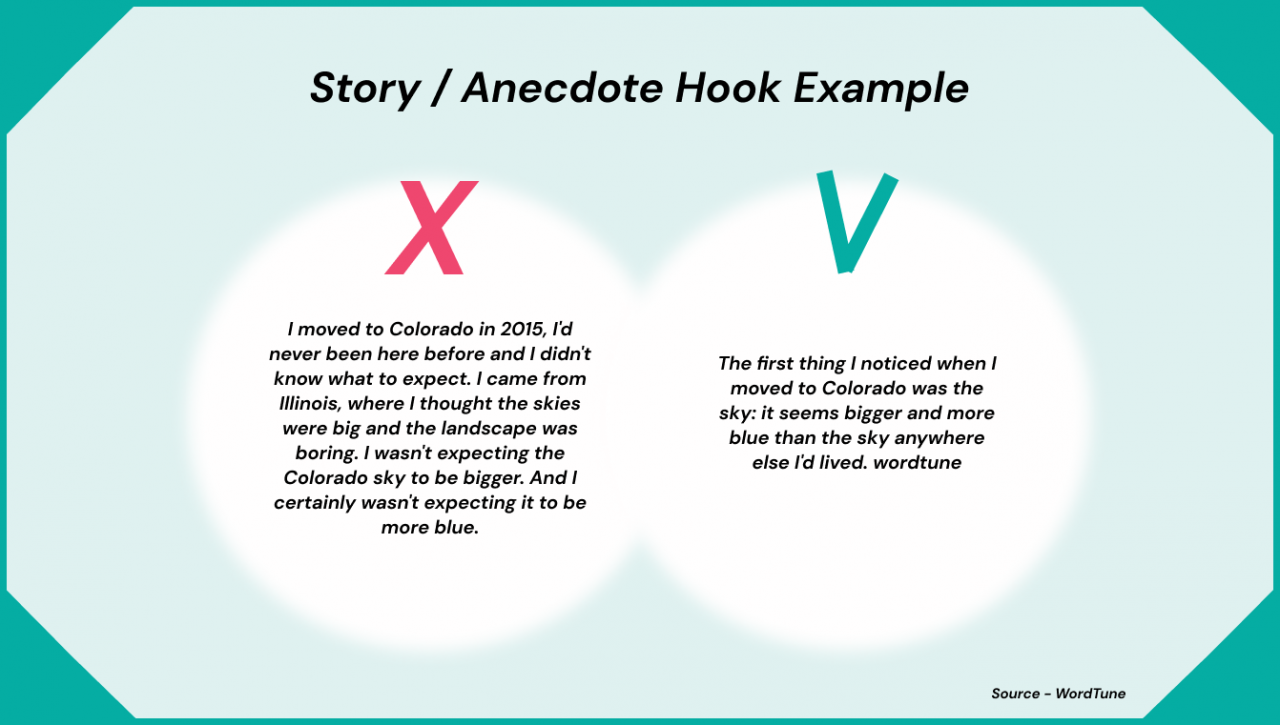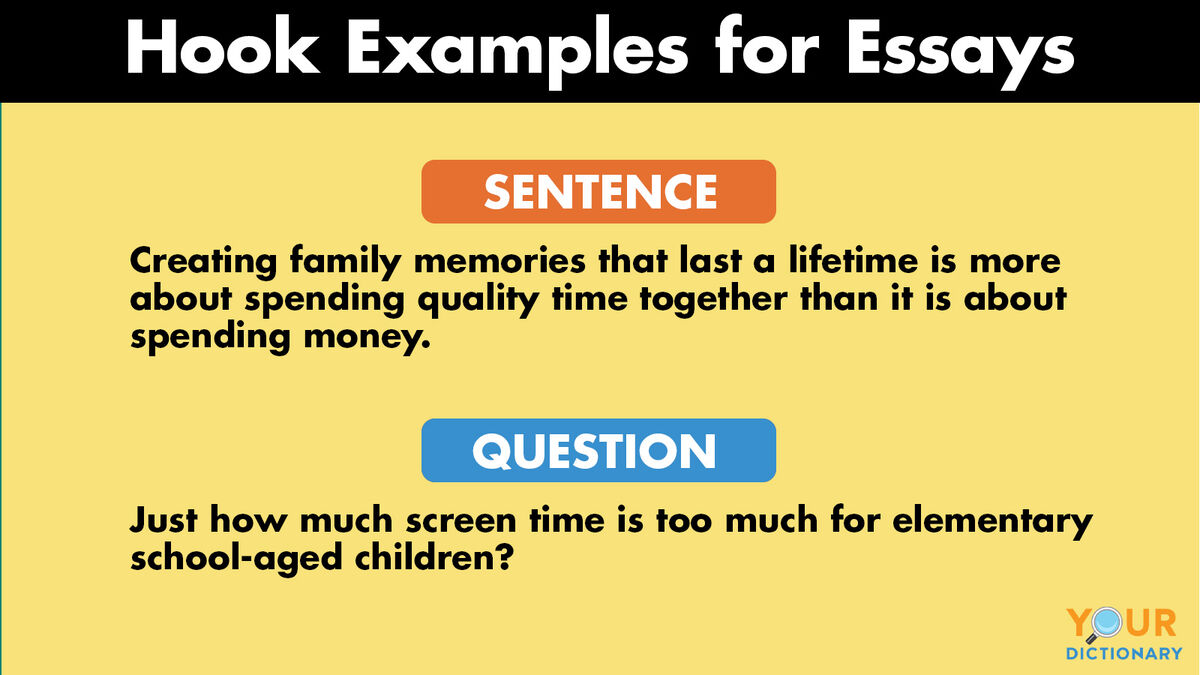A good grabber for an essay is like a magnet, drawing readers in and keeping them engaged from the very first sentence. It’s the literary equivalent of a cliffhanger, a tantalizing glimpse into the world you’re about to create.
In this essay, we’ll explore the art of crafting an effective grabber, examining the techniques used by master storytellers to capture attention and set the stage for a memorable reading experience.
Hook and Attention Grabbers
Crafting an effective hook is crucial for capturing readers’ attention and enticing them to continue reading. Compelling opening sentences that immediately engage readers are essential. These hooks can arouse curiosity, raise questions, or present unexpected details that pique readers’ interest.
To create effective hooks, consider using strong verbs that convey action and urgency. Vivid imagery and sensory details can also make your writing more engaging. Incorporating unexpected details or surprising facts can further captivate readers and leave a lasting impression.
Examples of Compelling Opening Sentences
- In a world where technology reigns supreme, one fateful night, a glitch in the system threatened to plunge humanity into chaos.
- The old mansion stood silently on the hill, its secrets hidden within its crumbling walls, waiting for someone to unravel its enigmatic past.
- Amidst the bustling city, a young woman embarked on a perilous journey that would test her limits and redefine her destiny.
Rhetorical Questions and Anecdotes
Rhetorical questions and anecdotes are powerful tools that can engage readers, provoke thought, and make essays more relatable. Rhetorical questions pose questions that do not require an answer, but instead prompt readers to consider a particular issue or idea. Anecdotes are brief stories or personal experiences that illustrate a point or make an argument more relatable.
Rhetorical Questions, A good grabber for an essay
Rhetorical questions can be used to:
- Draw attention to a particular issue or idea
- Challenge readers to think critically
- Emphasize a point
For example, the following rhetorical question draws attention to the issue of climate change:
“Can we afford to ignore the overwhelming scientific evidence that climate change is real and poses a serious threat to our planet?”
Anecdotes
Anecdotes can be used to:
- Establish a personal connection with the reader
- Make an argument more relatable
- Provide evidence to support a claim
For example, the following anecdote illustrates the importance of education:
“I grew up in a poor neighborhood, and I know firsthand how education can change a life. My parents worked hard to send me to a good school, and I am eternally grateful for the opportunities that education has given me.”
Techniques for Using Rhetorical Questions and Anecdotes Effectively
To use rhetorical questions and anecdotes effectively, consider the following techniques:
- Use rhetorical questions sparingly
- Make sure rhetorical questions are relevant to the topic
- Use anecdotes that are personal, relatable, and brief
- Use anecdotes to support a claim or illustrate a point
By following these techniques, you can use rhetorical questions and anecdotes to engage readers, provoke thought, and make your essays more relatable and persuasive.
Statistics and Data

Statistics and data play a pivotal role in supporting arguments and making them more persuasive. They provide concrete evidence and help establish the credibility of your claims. Here are some effective ways to use statistics and data in your essays:
First, it’s crucial to cite your sources and ensure that the data you present is accurate and unbiased. Rely on reputable sources such as government agencies, academic journals, or credible news organizations. Avoid using data from biased or unreliable sources, as they can compromise the validity of your argument.
Presenting Data Effectively
Once you have gathered reliable data, it’s important to present it in a clear and engaging way. Tables, charts, and graphs are effective methods for visualizing data and making it more accessible to readers. Choose the presentation method that best suits the type of data you have and the point you are trying to make.
- Tables:Tables are suitable for presenting numerical data in an organized manner. They allow for easy comparison of data points and can be used to highlight trends or patterns.
- Charts:Charts, such as bar charts, line charts, and pie charts, are useful for visualizing data and making it easier to identify trends and relationships. They can help readers quickly grasp the key points of your argument.
- Graphs:Graphs, such as scatter plots and histograms, are effective for displaying the distribution of data and exploring relationships between variables. They can help you identify patterns and correlations that may not be apparent from the raw data.
By using statistics and data effectively, you can strengthen your arguments, establish credibility, and make your essays more persuasive.
Personal Narratives and Experiences: A Good Grabber For An Essay
Personal narratives and experiences can add a powerful dimension to essays, making them more compelling, authentic, and relatable. By sharing your own stories and experiences, you can connect with readers on a personal level and create a lasting impact.
Crafting Effective Personal Narratives
- Be authentic:Write from the heart and share your genuine experiences. Authenticity resonates with readers and makes your narrative more believable.
- Choose a meaningful story:Select an experience that has had a significant impact on you or that relates to the topic of your essay.
- Use vivid language:Paint a picture with your words and engage the reader’s senses. Use descriptive language and sensory details to make your narrative come alive.
- Reflect and analyze:Take time to reflect on the experience you’re sharing and analyze its significance. This will help you draw insights and connect your narrative to the broader context of your essay.
Ethical Considerations
When using personal experiences in essays, it’s important to consider ethical boundaries. Ensure that you:
- Respect privacy:Avoid sharing personal information about others without their consent.
- Be mindful of consequences:Consider the potential impact of your narrative on yourself and others.
- Maintain integrity:Ensure that your narrative is honest and accurate. Avoid fabricating or exaggerating events.
Quotations and Allusions
In the realm of academic writing, quotations and allusions serve as powerful tools to enhance the depth and credibility of essays. They provide evidence from renowned sources, add literary flair, and establish connections with established works, thereby strengthening the writer’s arguments.
Finding and Selecting Quotations and Allusions
Finding and selecting appropriate quotations and allusions requires careful consideration. One effective approach is to explore works relevant to the topic and identify passages that resonate with the writer’s ideas. Online databases, such as Google Scholar or JSTOR, offer a vast collection of scholarly articles and books that can be searched using s related to the essay’s subject.
When selecting quotations or allusions, it is crucial to ensure their relevance to the essay’s thesis. The chosen passages should support the writer’s arguments and provide evidence or insights that enhance the essay’s credibility. It is also essential to consider the context of the quotation or allusion and ensure that it aligns with the writer’s interpretation.
Citing Sources and Avoiding Plagiarism
Properly citing sources is of paramount importance when using quotations and allusions. Failure to do so constitutes plagiarism, which undermines the integrity of the essay and can result in serious consequences. The writer must acknowledge the original source of the quoted or alluded material using an appropriate citation style, such as MLA or APA.
This includes providing the author’s name, the title of the work, and the publication date.
In addition to citing sources, it is essential to avoid plagiarism by paraphrasing or summarizing the original material rather than copying it verbatim. This involves using the writer’s own words to convey the main ideas of the quoted or alluded text while maintaining the original meaning.
Figurative Language and Imagery
Figurative language and imagery are powerful tools that can help you create vivid and memorable essays. When used effectively, they can bring your writing to life, engage your readers, and leave a lasting impression. Here are some examples of how to use figurative language and imagery in your essays:
Metaphors
A metaphor is a figure of speech that compares two unlike things without using the words “like” or “as.” For example, you might say that “life is a journey” or that “love is a fire.” These metaphors help us to understand abstract concepts by comparing them to something more concrete and familiar.
Similes
A simile is a figure of speech that compares two unlike things using the words “like” or “as.” For example, you might say that “the sky is as blue as the ocean” or that “her eyes are like sparkling diamonds.”
Similes can help us to create vivid images in our readers’ minds.
Personification
Personification is a figure of speech that gives human qualities to nonhuman things. For example, you might say that “the wind whispered through the trees” or that “the sun smiled down on us.” Personification can help us to create a more personal and engaging connection with our readers.
Other Literary Devices
In addition to metaphors, similes, and personification, there are many other literary devices that you can use to create vivid and memorable essays. These include:
- Hyperbole
- Understatement
- Irony
- Symbolism
- Alliteration
- Assonance
- Consonance
Importance of Originality
When using figurative language and imagery, it is important to avoid clichés and to use original and fresh language. Clichés are overused and unoriginal phrases that have lost their impact. For example, instead of saying that “the sun was shining brightly,” you could say that “the sun was a golden orb that cast its warm glow upon the earth.”
By using original and fresh language, you can create essays that are more engaging and memorable.
Humor and Irony
Humor and irony can be powerful tools for engaging readers and making essays more entertaining. When used effectively, they can help to lighten the mood, emphasize a point, or provide a fresh perspective on a topic. However, it is important to use humor and irony appropriately and avoid being offensive or disrespectful.
One of the keys to using humor effectively is to know your audience. What kind of humor will they appreciate? What topics are off-limits? It is also important to be mindful of the tone of your essay. Humor can be a great way to add some levity, but it is important to avoid being too silly or unprofessional.
Examples of Humor and Irony
- Exaggeration:Exaggerating a point can be a humorous way to emphasize it. For example, you could say that your professor is “so old, they taught dinosaurs how to read.”
- Understatement:Understating a point can also be humorous. For example, you could say that your essay is “not the best thing you’ve ever written.”
- Irony:Irony is a figure of speech that uses words to convey a meaning that is opposite to their literal meaning. For example, you could say that your essay is “a masterpiece of procrastination.”
Call to Action and Impact

Crafting a strong conclusion is crucial for leaving a lasting impression on readers. By employing persuasive language and a sense of urgency, writers can effectively motivate readers to think, feel, or take action.
A powerful call to action can inspire readers to act. For instance, in her essay “The Danger of a Single Story,” Chimamanda Ngozi Adichie concludes with a call to “show people their stories,” urging readers to challenge stereotypes and promote empathy.
Crafting Effective Conclusions
Effective conclusions can leave readers thinking deeply about the topic. In “The Myth of Sisyphus,” Albert Camus concludes by reflecting on the absurdity of life and the importance of finding meaning in the face of it. This thought-provoking ending prompts readers to contemplate their own existential journey.
Emotional impact can also be achieved through a strong conclusion. In “The Things They Carried,” Tim O’Brien concludes with a poignant description of the soldiers’ return home, leaving readers with a sense of loss and the lasting effects of war.
Using Persuasive Language and Urgency
Persuasive language can be employed to convince readers of a particular point of view. In his essay “Letter from Birmingham Jail,” Martin Luther King Jr. uses powerful rhetoric to argue for civil disobedience, urging readers to join the fight for equality.
A sense of urgency can be created by emphasizing the importance and timeliness of the issue. In her speech “We Can Do It!” Rosie the Riveter’s iconic image and slogan motivated women to join the workforce during World War II, instilling a sense of urgency and patriotism.
Sensory Details and Emotional Appeal
Sensory details and emotional appeal are powerful tools that can make essays more immersive and evocative. By engaging the reader’s senses and creating an emotional connection, writers can transport readers into the heart of their stories and leave a lasting impression.
One way to use sensory details is to focus on the five senses: sight, hearing, smell, taste, and touch. By describing what the characters see, hear, smell, taste, and touch, writers can create a vivid and realistic world for the reader.
For example, in the opening scene of Harper Lee’s To Kill a Mockingbird, Scout Finch describes the hot, humid Alabama summer in great detail: “The mockingbirds sang at us from the trees, but the children listened only to the sound of the tires crunching on the gravel.”
Another way to use sensory details is to focus on emotions. By describing the characters’ thoughts and feelings, writers can create an emotional connection with the reader. For example, in the opening scene of J.D. Salinger’s The Catcher in the Rye, Holden Caulfield describes his feelings of alienation and loneliness: “I’m standing on the edge of this crazy cliff.
What I have to do, I have to catch everybody if they start to go over the cliff—I mean if they’re running and they don’t look where they’re going I have to come out from somewhere and catch them. That’s all I’d do all day.
I’d just be the catcher in the rye and all.”
When used effectively, sensory details and emotional appeal can make essays more immersive, evocative, and memorable.
Techniques for Engaging the Reader’s Senses
- Use specific and vivid language.
- Focus on the five senses: sight, hearing, smell, taste, and touch.
- Use figurative language, such as similes and metaphors, to create a more vivid image in the reader’s mind.
- Avoid overused or clichéd descriptions.
Creating an Emotional Connection
- Describe the characters’ thoughts and feelings.
- Use dialogue to reveal the characters’ emotions.
- Use sensory details to create an emotional atmosphere.
- Avoid being overly sentimental or melodramatic.
Foreshadowing and Suspense
In the realm of storytelling, the judicious use of foreshadowing and suspense can be a literary masterstroke, creating an atmosphere of anticipation and keeping readers enthralled from beginning to end. These techniques serve as literary tools that tease, tantalize, and leave audiences yearning for more.
Techniques of Foreshadowing
- Subtle Hints:Drop subtle clues that hint at future events without revealing them outright. For instance, in “The Lord of the Rings,” Gandalf’s enigmatic line, “All we have to decide is what to do with the time that is given us,” foreshadows the arduous journey ahead.
- Symbolism:Employ symbolic objects or images that represent future developments. In “The Great Gatsby,” the green light at the end of Daisy’s dock symbolizes Gatsby’s unattainable dream.
- Prophecies and Dreams:Introduce prophecies or visions that hint at future events, building a sense of anticipation. For example, in “Harry Potter and the Order of the Phoenix,” Professor Trelawney’s prophecy about Harry and Voldemort sets the stage for the impending confrontation.
Building Suspense
- Pacing and Timing:Control the pace of the narrative, alternating between moments of tension and release. For instance, in “Jaws,” the slow, steady approach of the shark creates a palpable sense of dread.
- Unanswered Questions:Leave unanswered questions that pique readers’ curiosity and keep them guessing. In “Gone Girl,” the mysterious disappearance of Amy Dunne drives the plot forward, leaving readers on the edge of their seats.
- Red Herrings:Introduce misleading clues or characters to distract readers and keep them guessing. In “The Usual Suspects,” the unreliable narrator and multiple suspects create a labyrinth of deception.
Outcome Summary

From rhetorical questions to personal anecdotes, statistics to sensory details, the tools at your disposal are as vast as your imagination. By understanding the principles of effective grabbers and applying them to your own writing, you can transform your essays from ordinary to extraordinary, leaving a lasting impression on your readers.
Key Questions Answered
What makes a good grabber for an essay?
A good grabber is attention-grabbing, thought-provoking, and relevant to the topic of your essay. It can be a question, a startling statistic, a personal anecdote, or a vivid description.
How do I write an effective hook?
Start with a strong verb, use vivid imagery, and provide unexpected details. Keep it concise and to the point, and make sure it’s relevant to the topic of your essay.
What are some common mistakes to avoid when writing a grabber?
Avoid clichés, overused phrases, and irrelevant information. Don’t be afraid to be creative and original, but make sure your grabber is clear and easy to understand.